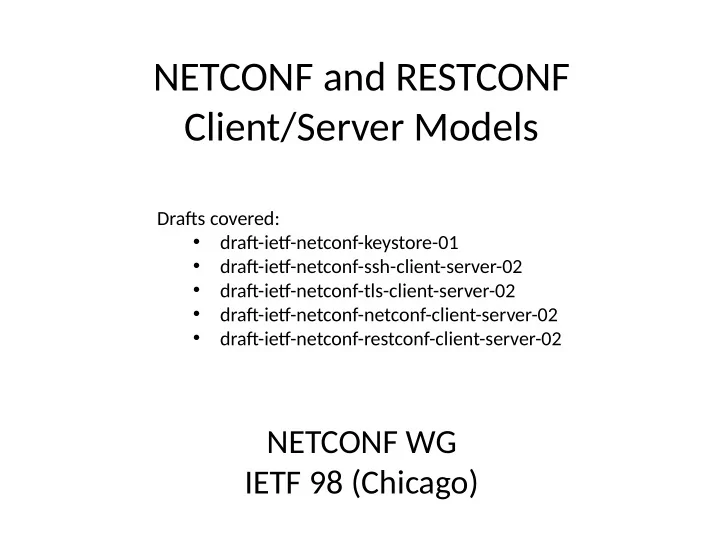

NETCONF and RESTCONF Client/Server Models Drafus covered: • drafu-ietg-netconf-keystore-01 • drafu-ietg-netconf-ssh-client-server-02 • drafu-ietg-netconf-tls-client-server-02 • drafu-ietg-netconf-netconf-client-server-02 • drafu-ietg-netconf-restconf-client-server-02 NETCONF WG IETF 98 (Chicago)
Recap • In the IETF 97 (Seoul), we reported litule progress on any of the drafus. • The only real change made to the drafus then was to address the keystore-renaming issue. • But we had said that, with zerotouch winding down, that the expectatjon was that these drafus would start to get more atuentjon. 2
Updates since IETF 97 • While zerotouch did NOT wind down as expected, these drafus stjll got a fair amount of atuentjon. • Keystore: – Replaced cert-chain idiom with PKCS#7 structures – Added 'private-key' as a confjgurable data node, and removed the 'generate-private-key' and 'load- private-key' actjons. – Moved 'user-auth-credentjals' to the ietg-ssh-client module. • SSH Client/Server – removed transport-specifjc grouping (module only defjnes one grouping now) – Simplifjed the "client-auth" part in the ietg-ssh-client module. It now inlines what it used to point to keystore for. – Added cipher suites for various SSH-specifjc algorithms. • TLS Client/Server – removed transport-specifjc grouping (module only defjnes one grouping now) – Filled in previously incomplete 'ietg-tls-client' module. – Added cipher suites for various TLS-specifjc algorithms 3
Updates since IETF 97 (cont.) • NETCONF Client/Server – Added to ietg-netconf-client ability to connected to a cluster of endpoints, including a reconnectjon-strategy. – Added to ietg-netconf-client the ability to confjgure connectjon- type and also keep-alive strategy. – Updated both modules to accommodate new groupings in the ssh/tls drafus. • RESTCONF Client/Server – Filled in previously missing 'ietg-restconf-client' module. – Updated the ietg-restconf-server module to accommodate new grouping 'ietg-tls- server-grouping’ • Other drafus are planning to use these models: – drafu-ietg-netmod-syslog-model – drafu-ietg-pce-pcep-yang 4
Open Issues • Keystore: – Should ‘private key’ be a union? – Add back `generate-private-key` actjon? • SSH Client/Server: – Simplifjed client-auth okay for call-home apps? Same Issue • TLS Client/Server: – Simplifjed client-auth okay for call-home apps? • NETCONF Client/Server: – Should NETCONF-client be a grouping? Same Issue • RESTCONF Client/Server: – Should RESTCONF-client be a grouping? 5
Should ‘private-key’ be a union? What should be the treatment for when NACM hides a value, resultjng in an invalid response? leaf private-key { nacm:default-deny-all ; type union { type binary ; type enumeration { enum " RESTRICTED " { description "The private key is restricted due to access-control."; } enum " INACCESSIBLE " { description "The private key is inaccessible due to being protected by the cryptographic hardware modules (e.g., a TPM)."; } } } mandatory true; description "A binary string that contains the value of the private key. The interpretation of the content is defjned in the registration of the key algorithm. For example, a DSA key is an INTEGER, an RSA key is represented as RSAPrivateKey as defjned in [RFC3447], and an Elliptic Curve Cryptography (ECC) key is represented as ECPrivateKey as defjned in [RFC5915]"; } 6
Add back `generate-private-key` actjon? This actjon was removed when we added ‘private-key’, protected by “nacm:default-deny-all” (see previous slide). But: 1. It is stjll best practjce to have a device generate the private key • so it never leaves the device) 2. The private key needs to be generated in hardware sometjmes • no optjon to set via confjguratjon My plan is a add this actjon statement back, with the explanatjon that it only updates the “operatjonal” datastore, so that certjfjcates can be confjgured on top of these system-generated private keys. Any concerns? 7
Simplifjed client-auth okay for call-home apps? • Works great for traditjonal clients, and also for call-home apps that want to use the same client-auth for ALL devices. • For more complicated call-home apps, is it okay to assume that the app would use business logic to handle special client-auth logic? module: ietf-ssh-client groupings: ssh-client-grouping Confjgures just a single client. +---- server-auth | ... +---- client-auth | +---- username? string | +---- (auth-type)? | +--:(certifjcate) | | +---- certifjcate? leafref {sshcom:ssh-x509-certs}? | +--:(public-key) | | +---- public-key? -> /ks:keystore/keys/key/name | +--:(password) | +---- password? union The SSH-client grouping is presented here. A similar single-client construct exists in the TLS-client grouping as well. 8
Should NC/RC-client be a grouping? • Having confjguratjon for NC/RC-servers makes sense – since the server's backend MUST implement the modules it claims to support. • But clients are difgerent – A client must have business logic of some sort to do something. Specifjcally, an NC/RC client needs to be linked into an applicatjon that orchestrates its functjon. • That being the case, how can a client ever be confjgured on its own? – Shouldn't the applicatjon itself be the thing that is confjgured? • Should these client models be groupings instead of a containers? 9
Next Steps • Work through remaining issues • Complete Call Home reference implementatjon – exercises ietg-ssh-server call-home confjguratjon • Wait for other implementatjons – Syslog? – PCE-PCEP? • Then Last Call Questjons, Comments, Concerns? 10
Recommend
More recommend